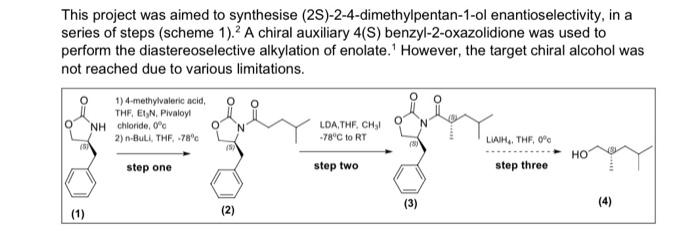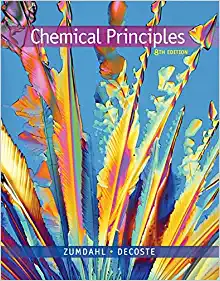Answered step by step
Verified Expert Solution
Question
1 Approved Answer
Suggest in depth improvements which address experiment design and are supported by literature (provide the reference too)? Answer should include reading from other papers This
Suggest in depth improvements which address experiment design and are supported by literature (provide the reference too)?
This project was aimed to synthesise (2S)-2-4-dimethylpentan-1-ol enantioselectivity, in a series of steps (scheme 1). 2 A chiral auxiliary 4(S) benzyl-2-oxazolidione was used to perform the diastereoselective alkylation of enolate. 1 However, the target chiral alcohol was not reached due to various limitations. General Experimental Method All experimental procedures were carried under an inert atmosphere of nitrogen. Thin layer chromatography was performed using Merck silica gel (60F-254, plated 0.25mm). Low temperature baths used in this experimental proceduse were: 78C (dry ice and isopeopanol), 30C (dry ice and isopropanol) and 0C (ice and waler). Carbon and proton magnetic resonance spectra ("CC NMR and "HNMR) were recorded on a Bruker Avance ill HD NanoBlay 400MHz NMR spectrometer. NMR analysis was carried out on Burker TopSpin 4.1.2, where chemical shifts were expressed in parts per million (pm) relative to the internal reference CDCl3(4C77ppm,1H7.25ppm). Infrared spectra was recorded and obtained on a Perkin-Elmer Spectrum two FT-AR spectrometer. Synthesis of (4S)-4-4benzyl-3-4-methylpentanoyl) oxazolidine-2-one: 4 -methylvaleric acid (0.40mL,2.72mmol,1.20q) was added to anhydrous THF (15mL) at 0 "C. Pivaloyl chloride (0.46mL,2.95.1.30eq) and triethylamine (0.6mL,3.86mmol,1.70eq) was added forming a thick while suspension. The mixture was stirred at 0C for a further 40 minutes, Separately, (4S)-4-benzyl-2-oxazolidinone (0.41g,3.09mmol,1 eq) was dissolved in anhydrous THF (15mL) and the mbture was stirred at 78:2.5M n-butylichium in hexane (1.10mL, 2.73mmol, 1.2eq) was added dropwise. The mixture was set to stir for 30 minutes at 78C. The lithio-(4S)-4-benzy-2-oxazolidinone reaction was transferred via canula to the anhydride solution and was stirred for 2 hours. The moture was warmed to room temperature, and was quenched with saturated ammonium chloride (2mL). THF was removed under reduced pressure. The resulting residue was washed sequentialy with saturated sodium carbonate (340mL) saturated ammonium chloride (340mL) and brine ( 340mL ). The colourless organic layer was dried over magnesium sulfate, fitered and concentrated in a rotatory evaporator providing a crude oil. Silica gel column chromatography (20% ethyl acetate in hexane) was used to purify the crude oll eluting the product (4S)-4-benzy)-3.(4-mothylpentancy)-oxazolidin-2-one as a colourless oil. (0.59g. 2.16 menol, 58%, IR (neat of) and NMR (20 mg in 700L of CDC13).R=0.26(20% ethy acotate in hexano), "H NMR (400 MHz, CDCl3, 5) 7.28(m,2H,CH(a)),7.19(m,1H,CH(b)), 7,12(d,J=6.82Hz,2H,CH(c)),5.28m,1H,CH(d)),4.40im,2H,CH(e)),4.10 (dd, J= 13.36, 4.02Hz,1H,CH(f),2.82(m,2H,CH(g),2.80(dd,J=13.36,9.60Hz,1H,CH(h)). 1.54(m,3H,CH(O),0.88(d,J=6.35Hz,6H,CHOKR ( KBr,vcm1)2985 (C-H (alkene), m), 2870 (C.H (alkane) m), 1761 (C=O (carbamate), s), 1698 (C=O(amide), s), 1605 (C=C, w), 1350(CN,s),1197(CO,s). Synthesis of compound 3, (4S)-4-benzyl-3-((2S)-2-dimethylpentanoyl)-oxazolidin-2one: Dilsopropylamine (0.45mL,3,23mmol,1.50eq) in THF (10mL) was cooled to 30C.2.5M n-butylithium in hexane (1.12mL,2.80mmol,1.30eq) was added to the mixture and stirred for 60 minutes. (4S)-4.benzyl-3.(4"- methylpentanoyl)-oxazolidin-2-one (0.59 g. 2.16 mmol, 1 eq) in anhydrous THF ( 5mL ) was cannulated into the LDA solution at 78C and stirred for 60 minules. lodomethane (0.20mL.3.23mmol,1.50eq) was then added to the mixture at 78C and stirred for a further 30 minutes. The solution was warmed to room temperature and the reaction was quenched with saturated ammonium chloride (5mL). THF was evaporated under reduced pressure. The mixture was extracted using diethyl ether. The organic extract was sequentially washed with: saturated ammonium chloride (330mL). saturated sodium bicarbonale (330mL), and brine (330mL). The yellow organic solution was dried over magnesium sulfate and concentrated in vacuo to peovide a crude cil (0.13g). Slica gel column chromatography was carnied out to purify the residue. The elution began with 10% diethyl ether in hexane to 50% diethyl ether in hexane to elute 2 impure fractions Answer should include reading from other papers 



Step by Step Solution
There are 3 Steps involved in it
Step: 1

Get Instant Access to Expert-Tailored Solutions
See step-by-step solutions with expert insights and AI powered tools for academic success
Step: 2

Step: 3

Ace Your Homework with AI
Get the answers you need in no time with our AI-driven, step-by-step assistance
Get Started


